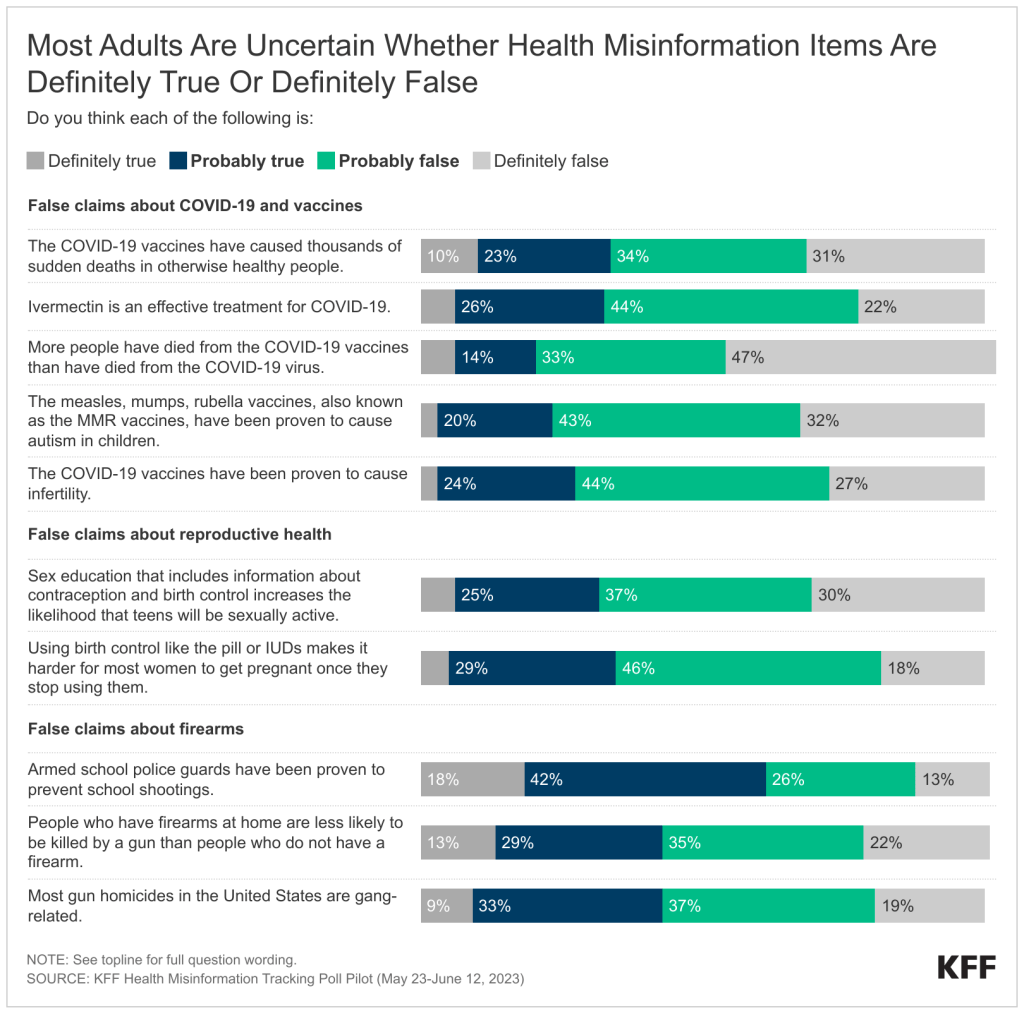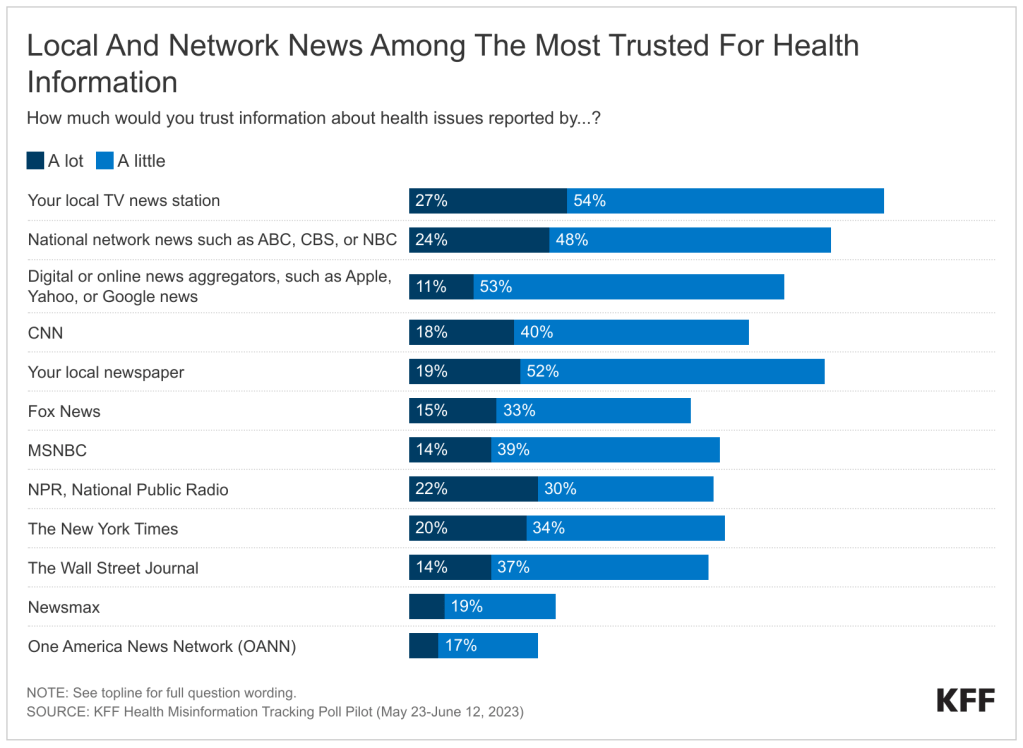
The independent source for health policy research, polling, and news.
Poll: Most Americans Encounter Health Misinformation, and Most Aren’t Sure Whether It’s True or False
Local TV and Broadcast News Among Most Trusted Sources for Health Information; Fewer Trust Social Media Sources
A new KFF survey reveals the broad reach of health misinformation, with at least four in 10 people saying that they’ve heard each of 10 specific false claims about COVID-19, reproductive health, and gun violence.
Relatively small shares say that each of those false claims are “definitely true”, ranging from as few as 3% who definitively believe that COVID-19 vaccines have been proven to cause infertility to as many as 18% who definitively believe armed school guards have been proven to prevent school shootings.
At the same time, roughly half to three-quarters of the public are uncertain whether each of the 10 false claims are true or not, describing them as either “probably true” or “probably false.” This suggests that even when people don’t believe false claims they hear, it can create uncertainty about complicated public health topics.
“Most people aren’t true believers in the lies or the facts about health issues; they are in a muddled middle,” KFF President and CEO Drew Altman said. “The public’s uncertainty leaves them vulnerable to misinformation but is also the opportunity to combat it.”

The new survey is one component of a new KFF program area aimed at identifying and monitoring health misinformation and trust in the United States, placing particular emphasis on communities that are most adversely affected by misinformation, such as people of color, immigrants and rural communities.
Alongside today’s survey findings, KFF will soon release companion survey reports highlighting the extent of health misinformation among Black and Hispanic adults, as well as rural residents. KFF will also soon release a regular “Health Misinformation Monitor,” which will document emerging health misinformation, identify its primary sources, and examine the role that social media and news outlets play in its spread. Sign up for alerts from KFF on this topic. KFF Health News is also expanding its reporting on this topic in conjunction with the new program.
“While many Americans struggle to separate health information fact from fiction, our survey shows that credible sources of information, and messengers, represent an opportunity to break through and help increase trust,” said Irving Washington, senior fellow for misinformation and trust at KFF. “We’ll continue to focus on this opportunity and what type of efforts can make a difference.”
The misinformation examined in the survey includes:
- Vaccines. A third (34%) of adults say the false claim that COVID-19 vaccines have caused thousands of sudden deaths in otherwise healthy people is definitely (10%) or probably (23%) true. Black adults are more likely to believe this false statement than White adults, while Republicans and independents are more likely than Democrats to do so. People with college degrees are less likely than those with a high-school education or less to say this is true.
- Reproductive health. About a third of adults say the false claim that using birth control such as the pill or an IUD makes it harder for most women to get pregnant once they stop using them is “definitely” (5%) or “probably” true (29%). Adults under the age of 65, Republicans, independents, and Black and Hispanic adults are more likely to say this claim is true than their counterparts.
- Gun violence. When asked about the inaccurate statement that people who have firearms at home are less likely to be killed with a gun, about four in ten (42%) say it is “definitely” (13%) or “probably” (29%) true. Gun owners are more likely than non-gun owners to say that this false claim is definitely or probably true (55% vs. 37%).
The survey also reveals how varied people’s beliefs and perceptions are about what constitutes misinformation. For example, when asked to describe specific misinformation related to COVID-19 that they’ve heard, people volunteered statements that were in direct contradiction with one another, including about the safety and effectiveness of COVID-19 vaccines and of wearing masks to prevent the virus’ spread.
Who People Trust for Health Information
The survey also gauges people’s trust in various sources of health information:
- Doctors. Not surprisingly, people overwhelmingly say that they trust their own doctor’s recommendations – with 93% saying they trust their doctors at least a fair amount.
- Federal agencies. About two thirds of the public say they have at least a fair amount of trust in the Centers for Disease Control (67%) and the Food and Drug Administration (65%) to make the right recommendations when it comes to health issues. Democrats are more likely than either independents or Republicans to trust the two federal agencies. About half of Republicans say they trust both the CDC (49%) and FDA (54%).
- Traditional news sources. The largest shares of the public say they would have at least a little trust in health information reported by their local TV news stations (80%), national network news (72%), and their local newspaper (72%). CNN is the most trusted cable news network (58%), with smaller shares trusting MSNBC (52%), Fox News (49%), Newsmax (25%) or One American News Network (22%). Fewer than three in ten adults say they have “a lot” of trust in health information from any of these media sources.
- Social media sources. About a quarter (24%) of adults say that they use social media at least weekly to find health information or advice, including larger shares of Hispanic and Black adults, and people in low-income households. Of eight specific social media sources, half (52%) would trust information about health issues they saw on YouTube at least a little. Fewer say they would trust health information if they saw it on Facebook (40%), Twitter (29%), Instagram (27%), and other platforms. Fewer than one in ten say they have a lot of trust in health information from any of these social media sources.

The survey report examines the sources to which people go to get their news and their susceptibility to misinformation. Less than half (45%) of adults say they have heard one of the five false COVID-19 and vaccine claims and believe it is definitely or probably true. That share rises to 76% of regular Newsmax viewers, and 67% of regular OANN viewers, and 61% of regular Fox News viewers.
Similarly, 54% of those who use social media for health information and advice at least weekly say they have heard at least one of the false COVID-19 and vaccine claims and think it is definitely or probably true, compared to 40% of those who don’t use social media for health advice.
Designed and analyzed by public opinion researchers at KFF, the KFF Health Misinformation Tracking Poll Pilot was conducted May 23-June 12, 2023, online and by telephone among a representative sample of 2,007 U.S. adults. Interviews were conducted in English and in Spanish. The margin of sampling error is plus or minus 3 percentage points for the full sample. For results based on subgroups, the margin of sampling error may be higher. Support for this work was provided by the Robert Wood Johnson Foundation (RWJF). The views expressed do not necessarily reflect the views of RWJF. KFF maintains full editorial control over all of its policy analysis, polling, and journalism activities.